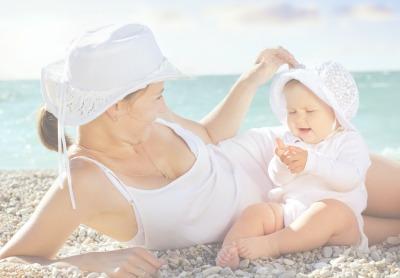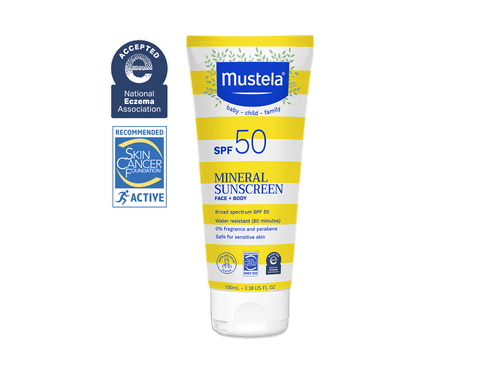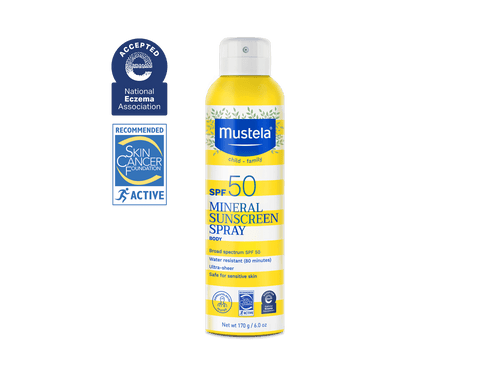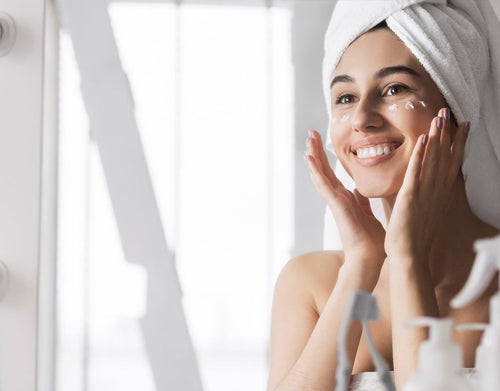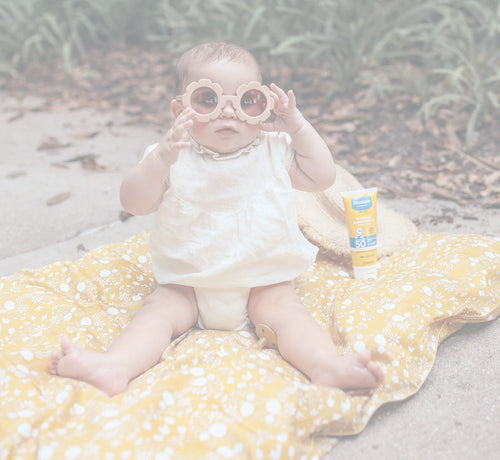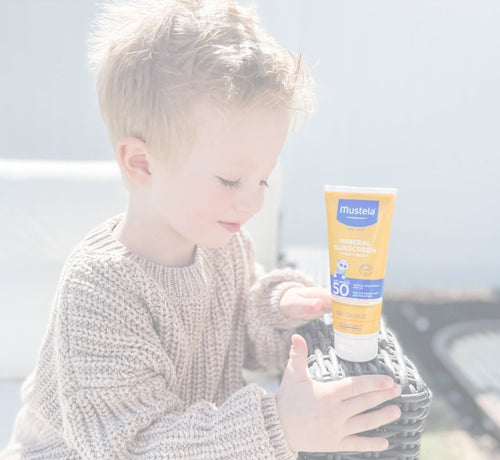We all love to enjoy a little sunshine. There’s nothing better than spending a gorgeous, sunny day outside with your baby. But too much exposure to direct sunlight can have serious consequences — in particular, baby sunburn, a condition that can appear in as little as 20 minutes.
So what’s a concerned parent to do? In this post, we’ll tell you everything you need to know about baby sunburn. We’ll start by explaining exactly what sunburn is. Then we’ll tell you how to best prevent it and give you 10 easy tips for treating your baby’s sunburn.
Table Of Contents
- What Exactly Is Baby Sunburn?
- What Are The Symptoms Of Baby Sunburn?
- How Can I Prevent My Baby From Getting Sunburned?
- 10 Easy Ways To Prevent Baby Sunburn

What Exactly Is Baby Sunburn?
We’re all familiar with sunburn. It’s the red, itchy, dry skin that results from too much time in the sun. In many cases, sunburn may burn the top layer of skin so severely that it peels off. But how does the sun cause such serious harm to our skin?
The sun gives off a number of different forms of light that reach the Earth: visible light, infrared radiation, and ultraviolet (UV) rays. The skin’s inflammatory reaction to UV rays is what we call sunburn.
While UV rays represent only a small fraction of the solar energy we receive, they have a major impact on your baby’s skin. Ultraviolet radiation (UVR) can be divided into three categories, depending on its wavelength:
- UVA rays, which have the longest wavelengths, are responsible for skin aging and wrinkles because they penetrate deeply into skin tissue and cause damage.
- UVB rays, which have a medium wavelength, are the rays primarily responsible for sunburn. They also increase the risk of skin cancer.
- UVC rays, which have the shortest wavelengths, are the most harmful. Fortunately, these rays do not reach the Earth’s surface because they are blocked by the atmosphere.
Our skin’s melanin is what defends against UV rays. Genetics account for how much melanin your skin has and whether you tan or burn — the less melanin you have, the more susceptible you are to sunburn.
As our skin soaks up the sun, UV rays injure skin cells. The damaged cells become red and swollen and then release toxins, which cause pain and discomfort. Extra blood flows to the capillaries in the affected area, giving sunburn its signature pink and red hue.
Peeling is common after sunburn. Your skin will peel as a way of getting rid of the damaged cells. It’s important to let your skin slough off.
While everyone is susceptible to sunburn, children are especially vulnerable to the risks of UV rays. This is because your baby’s skin is thin and delicate. Research has shown that serious sunburns, especially when they occur at a young age, may have health consequences later in life.
The effects include an increased risk of diseases like melanoma and other forms of skin cancer. That’s why sunburn prevention is so important for your baby.

What Are The Symptoms Of Baby Sunburn?
Cases of baby sunburn are pretty obvious. Symptoms include redness and swelling of the skin, pain, and sometimes blisters. Skin can also be hot to the touch, a sign that damage is still occurring.
Just like with adult skin, sunburn will dry out baby’s skin and may cause it to peel several days to a week later. If the sunburn is really severe, blisters may form to protect your little one’s body from infection.
How Can I Prevent My Baby From Getting Sunburned?
It’s an old sports adage that “the best defense is a good offense.” As such, the best way to treat your baby’s sunburn is to stop it from happening to begin with! Follow these simple steps to prevent your baby’s skin from getting burned by the sun.
Avoid Direct Sunlight
The first and most crucial step in baby sunburn prevention is avoiding too much time in direct sunlight. This doesn’t mean you should be afraid of sunlight and completely avoid taking your little one outside on sunny days.
Just be sure to limit the amount of time your baby spends in direct sunshine.
Try to find shady places to enjoy the outdoors, or bring the shade with you in the form of a parasol or umbrella. It should be noted the sun’s UV rays are the strongest between 10:00 a.m. and 4:00 p.m., so be extra careful during those hours.
Not only is the sun stronger at certain times of day but also in certain places. For instance, the sun can be even more damaging at higher altitudes. You’ll want to check the UV index before going outside, especially if you’re in a high-altitude region.
The higher the UV index, the more your baby’s skin will be susceptible to burning. However, even when the UV index is low, you still must take precautions.
It’s also important to know that your baby’s coloring can have an impact on how they respond to sunlight. If your child has blonde or red hair, has fair skin, or has never tanned, they are at higher risk for sunburn.
With less melanin in their skin, their natural defense against the sun is weaker. It’s best for them to avoid sun exposure as much as possible.
Lastly, although we say to avoid direct sunlight, it’s easy to forget reflected light. Sunlight can reflect off of surfaces like water and snow, making the rays even stronger, so an umbrella or hat might not be enough.
Even on a car ride, you have to take extra care, as UVA rays can penetrate windows, exposing your baby to direct sunlight.
Cover Up

The second best way to prevent your baby from getting a sunburn is to simply cover up their skin. Clothing is a great shield because it blocks almost all of the sun’s UV rays.
It might seem a bit strange to dress your baby in pants and a long-sleeved shirt when it’s warm out, but it’s better to be safe than sorry. You can still keep your baby comfortable in the heat by dressing them in loose, breathable, light-colored clothing.
If your baby is going to be out in the sunshine, it’s best to dress them in clothing made with Ultraviolet Protection Factor (UPF). The higher the number of UPF, the better. UPF will tell you how much UV radiation is absorbed by the clothing.
Clothing made with UPF generally has a tighter weave and is darker in color. That’s because darker and brighter colors absorb more UVR than white does.
Along with choosing clothing with UPF, you also want baby’s clothes to stay dry, as dry clothing protects better than wet clothing does.
But, of course, sometimes getting wet is the point, especially when you’re spending a day at the pool or on the beach. When it’s time to take a splash, a long-sleeved rash guard can be a good idea, as it will offer protection from UV.
Finally, accessories are non-negotiables when it comes to protecting baby from the sun — particularly wide-brimmed hats and sunglasses.
Choose sunglasses that have 100% UVA/UVB protection, as well as UVR protection. Protecting the eyes is important, as it’s thought that up to 80% of the damage to our eyes is done before the age of 18 — which can lead to eye problems like cataracts and retinal damage later in life.
Baby sunglasses should fit close to the face in order to offer the most protection — wrap-around styles are best. Also, you’ll want to choose sunglasses that are bendable but not breakable.

Apply Sunscreen
The third step to preventing baby sunburn is to use a baby-friendly sunscreen. But keep in mind sunscreen is only recommended for children six months and older.
For younger babies, it’s best to keep them out of direct sunlight. If you can’t avoid the sun, make sure they’re well-covered with long sleeves and a hat. For children over six months, it’s safe to apply a healthy layer of sunscreen on all exposed skin.
And you don’t just apply it once: You’ll have to reapply the sunscreen several times throughout the day — generally once every one-and-a-half to two hours, and after baby goes in the water. Speaking of water, it’s best to get a water-resistant formula.
Although we always think of applying sunscreen on sunny days, you want to keep in mind that UV protection is needed on cloudy days as well. No matter the weather, if your baby is going to be spending time outside, make sunscreen part of your daily routine.
It’s important to talk a little bit about which sunscreens are safe to use with young children as well. Many sunscreens can actually harm your baby because they contain chemicals that can seep into their bloodstream.
To avoid this safety hazard altogether, we recommend using a mineral-based sunscreen. These types of sunscreen use minerals to form a protective layer on your baby’s skin.
It’s also good to consider how the sunscreen is applied. Creams, lotions, gels, and sticks are generally easier than sprays for small babies, as you can control the amount you are using more precisely, and your little one won’t inhale it into their lungs.
Just be sure to choose a formula that is strong enough. The American Academy of Dermatology suggests that you choose a lotion that has SPF 30 or above for ample protection.

Finally, find a sunscreen that is labeled “broad spectrum.” This means that it will protect from both UVA and UVB rays. Mustela’s SPF 50+ Broad Spectrum Mineral Sunscreen Stick is the best option for parents who want to ensure their child is safe and protected from the sun.
Do A Patch Test
Now that you have chosen a safe sunscreen, let’s talk about how to use it.
Just to reiterate: If your baby is under six months old, sunscreen is not recommended for their age.
Before applying the new sunscreen on your baby older than six months, do a patch test on their arm. This is best done 48 hours before a full application to make sure that they don’t have any reaction to it. If they don’t react, generously apply it all over their little body.
Be sure you’re applying sunscreen on all of your older baby’s exposed skin, including the top of the ears, the back of the neck, and the tops of their feet. And don’t forget a protective balm for baby’s lips as well. The lips can be sensitive and are too often forgotten.
In addition, when you apply sunscreen on your little one, do so 30 minutes before sun exposure to ensure it’s effective. Keep in mind that it takes about 15 minutes to absorb into the skin.
Check Baby’s Medication
If your baby is taking medication, it’s best to be sure that it doesn’t increase sun sensitivity or make sunburn or rashes worse. For instance, some antibiotics, diuretics, and antihistamines are known to increase sensitivity to the sun.
If your little one is taking something that will make them more sensitive, try to keep them out of the sun altogether.
10 Easy Ways To Treat Baby Sunburn
In a perfect world, no baby would ever get sunburned. But we all know that accidents happen, and sometimes, children get a bit too much sun.
Although sunburn is common and usually not serious, severe sunburns may require a trip to the doctor’s office. If your child has any of the following symptoms, take them to your pediatrician as soon as possible.
- Fever
- Chills
- Nausea and/or vomiting
- Lightheadedness
Even if they don’t have these symptoms, if you’ve treated baby sunburn and your little one is still in pain or feels worse, you should make an appointment with their doctor.
Be mindful of your baby’s changes in behavior. You know your child, so trust your gut and err on the side of caution.
However, if your baby is just a little pink but doesn’t have any of these serious warning signs, then you’ll want to care for your loved one at home. Here are 10 simple steps you can take to treat baby sunburn.

1) Keep Your Baby Out Of The Sun
This first tip might seem obvious, but it’s so important that we felt the need to re-emphasize. If your baby has even the slightest amount of sunburn, keep them out of the sun for a few days.
It might not look like a serious burn, but any additional UV rays can quickly turn a mild burn into a severe one.
If you’re out for a stroll, be sure to use stroller shades and umbrellas. And if you’re going for a drive, install a UV window film on the car windows. UV window film can protect UVA rays from penetrating the windows and harming baby’s skin.
2) Give Your Baby A Cool Bath
Nothing soothes sunburn like a nice, cool bath. For additional soothing power, add oatmeal or baking soda to your little one’s bathwater. The bath will not only make your baby’s sunburn feel better, but it will also allow them to take their mind off the discomfort for a while.
You don’t want them in the tub so long they catch a chill, so 10 minutes should be just right.
Another tip: Don’t use any soap on the sunburn as this can make it more uncomfortable. Also, be extremely gentle when you pat baby dry after the bath.
3) Apply A Baby-Safe Cream

Much of the damage caused by baby sunburn is from the skin drying out. That’s why it’s important to get it moisturized as soon as possible.
You want to use moisturizer right after bathtime and apply it to damp skin. You might also want to lather on lotion right before bedtime.
Applying a gentle, baby-safe cream will soothe your baby’s skin and help heal their sunburn. Try Mustela’s multi-purpose balm with 3 avocado extracts to give your baby maximum relief.
4) Avoid Popping Or Breaking Any Blisters That May Appear
In more serious cases of sunburn, your baby’s skin may form small blisters. It’s best to leave these blisters alone, as popping them increases the chance of a bacterial infection or scarring. Besides, blisters can help the skin heal.
If a blister happens to pop accidentally, use a small pair of clean scissors to trim off any dead skin. Then, you can wash the area very gently (it may be painful), apply an antibiotic ointment, and cover it with a bandage.
Of course, it will be very important to protect that sensitive area from any additional sun exposure while it heals.
5) Place A Cloth Soaked In Cold Water On The Sunburn
This simple treatment can work wonders for sunburn. All you need to do is soak a soft cloth in cold water for a few minutes, quickly wring it out, and let it sit on your baby’s sunburn. The cool, wet cloth will provide instant relief and allow your little one to relax.

6) Give Your Baby Extra Fluids
After developing a sunburn, your baby is probably a bit dehydrated. This is because a sunburn brings fluid to the surface of their delicate skin and away from the rest of their body.
To solve this problem, simply give your baby extra fluids for several days. These extra fluids will keep your baby’s body in tip-top shape so it can naturally heal its sun-damaged skin.
Be sure to watch that your little one is urinating regularly, and if not, contact their doctor right away.
7) Avoid Using Ice And Water As Treatment
While a cool bath and cloths soaked in cold water are OK, you shouldn’t use ice or ice water to treat your baby’s sunburn. In fact, ice and ice water can make a sunburn hurt more. Your baby’s skin is delicate and easily irritated, so putting freezing-cold ice on top of a sunburn is not helpful.
8) Administer A Small Dose Of Ibuprofen Or Acetaminophen
For older babies, a small dose of ibuprofen or acetaminophen can help relieve pain and reduce swelling caused by the sunburn. Generally, ibuprofen is recommended for children six months or older. Acetaminophen is similar but can sometimes be approved for younger babies.
The medicine is best started soon after the burn as it will cut down on the pain and swelling, making your baby more comfortable. Of course, as always, it’s best to check with your doctor before giving your little one any medicine.
9) Use Gentle Cleansers On Your Baby’s Skin

When bathing your baby, always observe good washing habits and use gentle cleansers rather than harsh soaps. Mustela’s Gentle Cleansing Gel is an effective option for your baby’s delicate skin.
10) Give Your Baby Lots Of Extra TLC!
This might not directly heal your baby’s sunburn, but it will certainly make your little one feel better! There’s no remedy quite like extra hugs and kisses from mom and dad.
Sun Safe With Baby

Being sun-smart is important for your baby’s future skin. Luckily, good sun safety practices and products make it easy to avoid. Get ahead of potential sunburn with the strategic use of shade, UV-blocking clothing, and, of course, lots of baby-safe mineral-based sunscreen.
If your little one does get sunburned, just follow the 10 easy tips we shared — including a cool bath, extra fluids, and baby-safe creams. Above all, keep them out of the sun until they heal, and be sure to use sunscreen the next time you’re outside.
Our baby sunscreen is your first line of defense against the sun’s harsh rays. Our fragrance-free, non-nano mineral sunscreen protects not only baby’s delicate skin but everyone’s in the family.
With Mustela, you can look forward to safe, sunny family fun with your little one!


